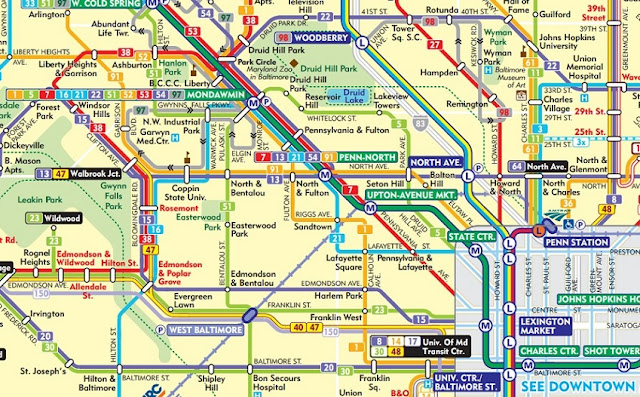 |
| Determined riders do their best to thread through the MTA maze, but can the agency make it worth the trouble?
Photo by: detail, Maryland Transit Administration route
|
Some ways to get Baltimore's mass transit system back on track.
Here's a little story I wrote that appeared in the Baltimore Brew on March 16, 2012 which sums up the basic principles of transit system structure that the MTA violates with impunity. It followed an impassioned account from a rider that appeared three days before, announcing she was giving up on the MTA.
Rude, sadistic bus drivers are but the tip of the symptomatic iceberg, when it comes to what’s ailing the Maryland Transit Administration. Actually, bus drivers are victimized by the same impossible transit system that riders have to deal with.
Here are 10 rules of transit planning which the MTA mostly violates with impunity, but if they would adhere to them, bus drivers could actually succeed in making the system work.
1 – The rail system should carry as much of the ridership load as possible. The empty seats on the rail system are the MTA’s biggest best untapped resource and potential economy of scale. In this regard, the Mondawmin Metro feeder bus hub is one of the few places where the system actually mostly works.
2 – All bus routes should be as short as possible. The longer a route, the more possibilities for things to go wrong and the farther buses can get behind schedule.
3 – A hierarchy of long and short routes should be established, allowing each to do what it can do best.
4 – For short routes, speed is less important and frequency is more important. High frequency makes reliability less of an issue because if a bus doesn’t come, another is scheduled to arrive soon. The city’s Charm City Circulator, which has an altogether more relaxed atmosphere than the MTA buses, can be a model. Redundancy with the Circulator, however, prevents more frequent service and needs to be eliminated.
5 – For long routes, speed is far more important, so routes should be located on faster roads with fewer stops. The MTA’s recent introduction of “Quick Bus” routes is a step in the right direction.
6 – Routes must be branded. Shorter routes can be branded for local neighborhood identity, creating a sense of local pride of ownership: “This is OUR bus route.” Riders will then demand courtesy from both drivers and each other, just like guests in our homes. Splitting the #1 line into branded South Baltimore and Sandtown lines makes a lot more sense than a temporary Fort McHenry Circulator.
7 – Fares should vary by trip or route length instead of “one fare fits all,” which defies all transportation marketing and economic sense. The electronic Charm Card creates opportunities for this which the MTA has so far ignored.
8 – There should be a comprehensive system of transit connection hubs, especially for the rail system, to replace the current system chaos with a coherent structure. An easy place to start is the parking lot next to the MTA’s Lexington Market Metro operations building on Eutaw Street, north of Saratoga Street.
9 – By far the most important rail system expansion priority must be to extend the Metro beyond Hopkins Hospital to a comprehensive transit hub comparable to the DC Metro/MARC New Carrollton Station. The official proposal to extend it to North Avenue/Broadway by 2035 would come far too late and virtually preclude any future extensions beyond that. A far cheaper extension to Edison/Monument could be done far sooner and facilitate future extensions to Bayview, Canton, White Marsh, Middle River and Dundalk.
10 – The proposed multi-billion-dollar Red Line is almost totally irrelevant to Rules 1-9. The continued existence of this plan merely demonstrates how the lame, directionless MTA has been manipulated by the developers, the Greater Baltimore Committee, City Hall, etc.










.jpg)
.jpg)



+(840x630).jpg)
.jpg)
.jpg)

.jpg)
.jpg)






